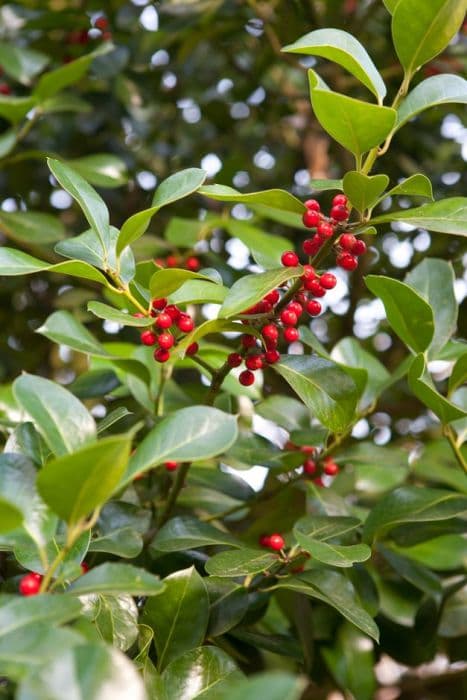English Holly Ilex aquifolium

ABOUT
Commonly known as the English holly, this plant is renowned for its rich, dark green leaves that are glossy and often bear a spiky edge. Each leaf boasts a unique wave-like contour with sharp points that can deter animals from eating it. The leaves are alternately arranged along the branches, creating a dense foliage that is evergreen, meaning it retains its color all year round. During the flowering season, small white blossoms may appear, which are generally inconspicuous yet fragrant. These flowers give way to the plant's most distinctive feature: the bright red berries that emerge in the autumn and winter. These berries are a stark contrast against the green leaves, providing a classic holiday appearance that has made the English holly a symbol of Christmas. Birds and other wildlife are often attracted to these berries, although they are considered toxic to humans. The plant's overall form is usually that of a bushy, dense evergreen, contributing to its popularity as a hedge or ornamental specimen in gardens and parks. The contrast between the shiny green leaves and vivid red berries makes it a visually appealing plant that stands out in various landscapes. Additionally, English holly is known for its bark, which is smooth and light grey when the plant is young, becoming darker and more cracked with age.
About this plant
 Names
NamesFamily
Aquifoliaceae.
Synonyms
English Holly, European Holly, Christmas Holly.
Common names
Ilex balearica, Ilex acutifolia, Ilex perado, Ilex aquifolium f. bacciflava, Ilex aquifolium var. crassifolia, Ilex aquifolium b. platyphylla.
 Toxicity
ToxicityTo humans
Ilex aquifolium, commonly known as the English holly, is considered toxic to humans. The plant contains compounds such as saponins and theobromine, which can cause symptoms if ingested. These include gastrointestinal upset, such as nausea, vomiting, and diarrhea. If a large quantity of the berries is consumed, more severe symptoms can occur, including drowsiness, dehydration, and decreased blood pressure. In rare cases, if a significant enough quantity is ingested, it can be potentially fatal, especially for children. It is advised to seek medical attention if ingestion occurs.
To pets
Ilex aquifolium, widely known as the English holly, is also toxic to pets, including dogs and cats. Ingesting parts of the plant, especially the berries and leaves, can lead to similar symptoms as in humans, such as vomiting, diarrhea, and drooling. There is potential for more severe reactions such as depression, drowsiness, and changes in behavior. Depending on the amount consumed, it might lead to dehydration and a decrease in blood pressure. If a pet has ingested English holly, it is crucial to contact a veterinarian immediately.
 Characteristics
CharacteristicsLife cycle
Perennials
Foliage type
Evergreen
Color of leaves
Green
Flower color
White
Height
15 feet (4.57 meters)
Spread
10 feet (3.05 meters)
Plant type
Tree
Hardiness zones
5
Native area
Europe
Benefits
 General Benefits
General Benefits- Wildlife Attraction: Ilex aquifolium, commonly known as European Holly, offers berries that serve as a food source for birds and small mammals during the winter months.
- Ornamental Use: Known for its bright red berries and glossy, spiky green leaves, it is widely used for Christmas decorations and is a popular ornamental plant in gardens and parks.
- Hedging and Privacy: European Holly can be used to create dense, evergreen hedges that provide privacy and wind protection throughout the year.
- Drought Resistance: Once established, it is relatively drought-tolerant, reducing the need for constant watering and making it suitable for a variety of climates.
- Shade Tolerance: It can grow well in shaded areas where other plants may struggle, making it adaptable to different garden conditions.
- Erosion Control: Its root system can help stabilize soil and prevent erosion, particularly in sloped areas of a landscape.
- Cultural Significance: European Holly holds significance in various cultures, especially as a symbol of Christmas and winter festivities.
- Wildlife Shelter: The dense foliage provides excellent cover and nesting opportunities for birds and other wildlife.
 Medical Properties
Medical Properties- Anti-inflammatory: Ilex aquifolium leaves have been historically used to reduce inflammation.
- Diaphoretic: It has been used to induce sweating and help reduce fevers.
- Diuretic: The plant has been used to promote the flow of urine, which can assist in the cleansing of the urinary tract.
- Expectorant: Ilex aquifolium has been reported to help in expelling phlegm from the respiratory passages.
 Air-purifying Qualities
Air-purifying QualitiesThis plant is not specifically known for air purifying qualities.
 Other Uses
Other Uses- Ilex aquifolium, commonly known as European holly, has been traditionally used to craft jewelry such as brooches and earrings due to its glossy leaves and bright red berries.
- In some cultures, the wood of the European holly is used for making walking sticks and canes, valued for its toughness and fine grain.
- The dense foliage of the European holly provides protection and nesting opportunities for birds, making it an ideal plant for encouraging wildlife in gardens.
- Due to its evergreen nature and prickly leaves, European holly has been used as a natural livestock barrier when planted in dense hedges.
- In woodturning and cabinetmaking, the hard, white wood of the European holly is valued for inlay work and detailed engravings.
- The European holly is often used as a winter forage plant for beekeeping, providing bees with a source of nectar during the colder months.
- European holly leaves have been used in the past for holiday-themed stamps and stencils for crafting and decorating purposes.
- The plant is also used in topiary, taking advantage of its dense growth habit and the ability to retain its shape well when clipped.
- Due to its association with Christmas, European holly branches are sometimes used to craft seasonal wreaths and garlands.
- European holly's resistance to pollution and salt makes it a suitable choice for urban and coastal planting in challenging environments.
Interesting Facts
 Feng Shui
Feng ShuiThe Holly is not used in Feng Shui practice.
 Zodiac Sign Compitability
Zodiac Sign CompitabilityThe Holly is not used in astrology practice.
 Plant Symbolism
Plant Symbolism- Foresight: Ilex aquifolium, commonly known as Holly, is often associated with protection and foresight due to its evergreen nature, which allows it to thrive in harsh winter conditions.
- Protection: The sharp leaves of the Holly symbolize a shield against negative forces and the ability to ward off harm, suggesting a need for safeguarding what one holds dear.
- Immortality: As an evergreen, Holly represents eternal life and is often associated with Christmas as a reminder of rebirth and the everlasting aspect of nature.
- Good Fortune: Holly is also seen as a bringer of good luck, and hanging it in the home around the holidays is thought to invite positivity and prosperity.
- Hope: The vivid red berries of the Holly emerge during the winter months, symbolizing hope and the promise of renewal during the darkest times of the year.
 Water
WaterThe common holly, or Ilex aquifolium, prefers consistent moisture but doesn't require constant wet soil, so it is important to allow the top inch of soil to dry out before watering again. Water this plant deeply and thoroughly, which could range from once a week during hot, dry weather to every two to three weeks during cooler, rainy periods. Aim to provide between 1 to 1.5 gallons of water for smaller shrubs, increasing the amount as the plant matures and depending on the size, weather, and soil conditions.
 Light
LightEnglish holly, or Ilex aquifolium, thrives in locations where it can receive full sun to partial shade. It performs best when it gets at least 4 to 6 hours of sunlight a day, so placing it in a spot that gets morning sunlight with some afternoon shade is often ideal to protect it from the harshest rays, especially in hotter climates.
 Temperature
TemperatureEnglish holly is hardy and can survive in a wide range of temperatures, generally tolerating minimum temperatures down to about -20 to -10°F and withstanding highs up to 90°F. However, the ideal temperature range for Ilex aquifolium is between 50°F and 80°F for optimal growth and health.
 Pruning
PruningPrune English holly to maintain its shape and encourage bushier growth, as well as to remove any damaged or diseased branches. The best time to prune is in winter when the plant is dormant, or early spring before new growth begins. Pruning is generally required once a year, but for hedges or formal shapes, you may need to prune more frequently to maintain the desired appearance.
 Cleaning
CleaningAs needed
 Soil
SoilHolly prefers well-drained, loamy soil with a slightly acidic to neutral pH, typically around 5.5 to 7. For optimal growth, a mix containing peat, sand, and garden loam is beneficial. Mulching around the base can help retain moisture and keep the roots cool.
 Repotting
RepottingEnglish Holly, being a slow-growing plant, does not require frequent repotting. It is typically repotted every 2 to 3 years or when it has become clearly pot-bound or the soil has degraded.
 Humidity & Misting
Humidity & MistingEnglish Holly tolerates a range of humidity levels but thrives best in moderate to high humidity. It is flexible in typical household humidity levels but prefers consistent moisture in its environment.
 Suitable locations
Suitable locationsIndoor
Grow in bright, indirect light with moderate watering.
Outdoor
Plant in partial shade, shelter from strong winds.
Hardiness zone
5-9 USDA
 Life cycle
Life cycleIlex aquifolium, commonly known as the European holly, begins its lifecycle when seeds are dispersed by birds and other animals, after which they go through a period of dormancy. Upon germination, which may be slow and irregular, a seedling emerges and gradually develops into a young plant. The young holly plant, or sapling, then spends several years growing into a mature shrub or tree, during which time it develops the characteristic spiny leaves and begins to produce flowers. The plant reaches full maturity at around 20-50 years of age and can start producing flowers and fruit; the flowers are small and white and pollinated by insects. Once pollinated, the female plants produce the iconic red berries which remain on the tree throughout winter. The European holly can live for several hundred years, during which it will continue to undergo cycles of flowering and fruiting, contributing to the growth of new holly plants.
 Propogation
PropogationPropogation time
Spring-Early Summer
The most common name for Ilex aquifolium is the English holly. A popular method of propagation for this plant is through seed. English holly seeds require a period of cold stratification to break dormancy, a process which simulates winter conditions. After collecting the red berries, which are typically ripe from September through November, remove the seeds from the flesh and then subject them to cold stratification for approximately 18 to 24 months. This can be accomplished by mixing the seeds with slightly moist sand and storing them in a refrigerator at a temperature of about 34-40 degrees Fahrenheit (1-4 degrees Celsius). Sow the stratified seeds in the spring in a well-draining soil mix. It's important to be patient as English holly can take multiple seasons to germinate and may not produce a high germination rate.









